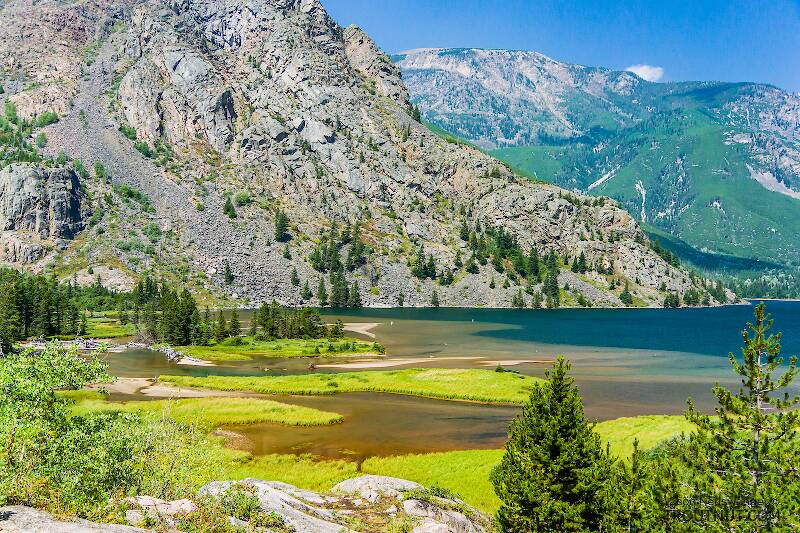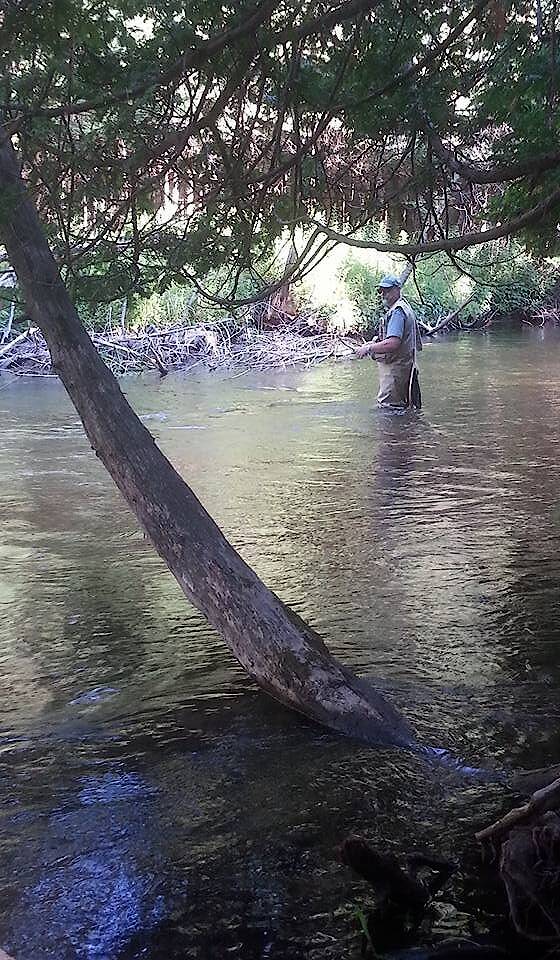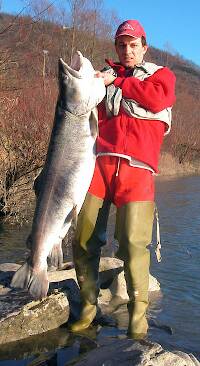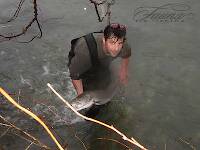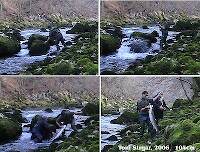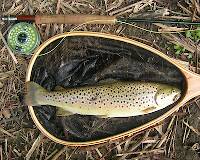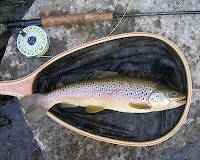
Salmonflies
Pteronarcys californica
The giant Salmonflies of the Western mountains are legendary for their proclivity to elicit consistent dry-fly action and ferocious strikes.
Featured on the forum

This specimen keys pretty easily to Onocosmoecus, and it closely resembles a specimen from Alaska which caddis expert Dave Ruiter recognized as this genus. As with that specimen, the only species in the genus documented in this area is Onocosmoecus unicolor, but Dave suggested for that specimen that there might be multiple not-yet-distinguished species under the unicolor umbrella and it would be best to stick with the genus-level ID. I'm doing the same for this one.

Troutnut is a project started in 2003 by salmonid ecologist Jason "Troutnut" Neuswanger to help anglers and
fly tyers unabashedly embrace the entomological side of the sport. Learn more about Troutnut or
support the project for an enhanced experience here.
WI_Fisher
Posts: 8
Posts: 8
WI_Fisher on Dec 15, 2016December 15th, 2016, 9:59 am EST
So I've been having very good success fishing with sizes 18-14 nymphs but the trout I catch are never over 12 inches. I guess my question is if I want bigger trout should I start using bigger flies/streamers? Whenever I look under rocks all of the bugs seem to be around the size that I've been using, maybe some a tad bigger. Can you catch bigger trout with size 12-18 flies?
Wbranch on Dec 16, 2016December 16th, 2016, 4:13 am EST
Can you catch bigger trout with size 12-18 flies?
Sure you can! Most mayflies and caddisflies are in the #12 - #18 size ranges and lots of big trout like to eat them. I'd bet those sized insects make up at least 50% of the food available to trout and I'm guessing they are easier to catch than chasing minnows. I've caught hundreds of 18" - 21" browns and rainbows on flies in the #14 - #18 range.
Catskill fly fisher for fifty-five years.
PaulRoberts on Dec 16, 2016December 16th, 2016, 8:01 am EST
The big trout have to be there in the first place.
And, how big trout earn their livings differ with water body size and type.
Are you fishing small waters or big? Freestone or tailwater? ...
And, how big trout earn their livings differ with water body size and type.
Are you fishing small waters or big? Freestone or tailwater? ...
Wbranch on Dec 16, 2016December 16th, 2016, 8:27 am EST
Paul has made some very good points. Those larger trout have to be present in the bodies of water you fish in decent numbers or else you may not see them very often. Typically tail water rivers due to their consistent flows and water temperature and insect life will support far more larger trout than freestone rivers found in northern and cooler climates. I am not a scientist nor very astute in fisheries biology so most of my opinions are just that - stuff I have kind of figured out over the last half century of fly fishing.
Catskill fly fisher for fifty-five years.
WI_Fisher
Posts: 8
Posts: 8
WI_Fisher on Dec 16, 2016December 16th, 2016, 10:05 am EST
Well I'm not sure if I'm allowed to name the river I fish, I know some sites don't like that and I'm not sure if this is one of those. I fish on a small river in Wisconsin so I would assume it would be tailwater?
So then the odds are the same then? It'd just seem better odds using a streamer or big fly because smaller trout wont try to go after it?
Also when I say smaller trout I mean anything smaller than 12 inches, and bigger trout would be like 14 inches and up.
Thanks for the help
So then the odds are the same then? It'd just seem better odds using a streamer or big fly because smaller trout wont try to go after it?
Also when I say smaller trout I mean anything smaller than 12 inches, and bigger trout would be like 14 inches and up.
Thanks for the help
Wbranch on Dec 16, 2016December 16th, 2016, 2:48 pm EST
I fish on a small river in Wisconsin so I would assume it would be tailwater?
Firstly your definition of a tailwater, relative to how most fly fishers think of that word, is incorrect. I tailwater is any river that emanates below a dam, usually with a bottom release, so cold water flows through the river all year round. Additionally it most often means a river system with a pretty constant flow. Because of the presence of the dam and a huge impoundment of water the flow remains quite the same except in areas where snow pack plays a large part and spring and early summer thaws up in the mountains can raise the water levels significantly.
Also when I say smaller trout I mean anything smaller than 12 inches, and bigger trout would be like 14 inches and up.
Small, and big, are very relative terms when it comes to fly fishing. Many guys who fish little mountain creeks with wild brook trout consider a 10" brookie to be a real trophy. In my fishing anything under 10" is a small trout but on the other end of the spectrum they aren't big in my mind until they are 18". My Montana fishing partner doesn't think of a trout being big unless it is at least 20".
Small trout
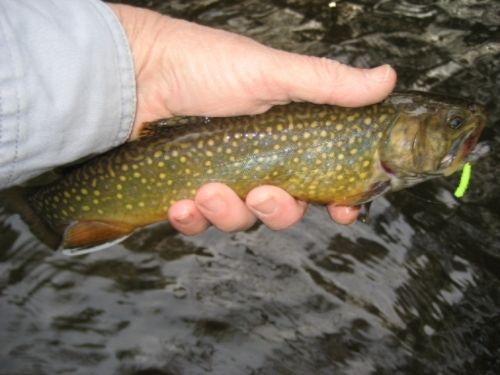
Bigger trout - on a #16 Green Body Copper John
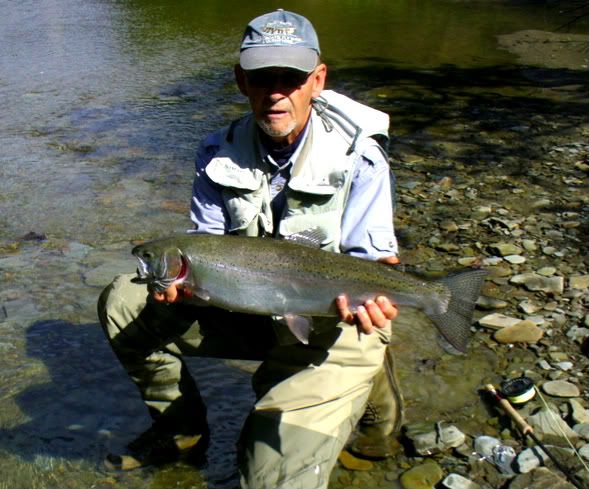
Catskill fly fisher for fifty-five years.
Wiflyfisher on Dec 17, 2016December 17th, 2016, 1:25 am EST
I guess if your goal is to catch big trout then streamers or woolly buggers are one way to try to achieve your goal. Using bigger flies means you can also use heavier tippets and increase your odds of landing a big fish. At the same time for many of us on this forum we have caught a lot of big trout on small flies with finer tippets.
As Paul mentioned you have to be sure larger trout exist where you are fishing. but large trout when conditions are right will eat small insects as well. I have read that some of the WI driftless streams are over populated with trou,t so the trout in those streams would tend to be smaller because they are all competing for the food supply.
If you can time it right to be on the stream when a good hatch is coming off you should have a good chance to observe the trout population in that stream. Also, find some good pools and throw a streamer at dusk may show you whether there are any really good sized trout in that stream.
As Paul mentioned you have to be sure larger trout exist where you are fishing. but large trout when conditions are right will eat small insects as well. I have read that some of the WI driftless streams are over populated with trou,t so the trout in those streams would tend to be smaller because they are all competing for the food supply.
If you can time it right to be on the stream when a good hatch is coming off you should have a good chance to observe the trout population in that stream. Also, find some good pools and throw a streamer at dusk may show you whether there are any really good sized trout in that stream.
John S.
https://WiFlyFisher.com
https://WiFlyFisher.com
WI_Fisher
Posts: 8
Posts: 8
WI_Fisher on Dec 17, 2016December 17th, 2016, 2:35 am EST
Thanks for clearing this up for me. I've never tried streamers or a woolly bugger but I figure I'll start to learn those in the coming season.
thanks again
thanks again
Jmd123 on Dec 17, 2016December 17th, 2016, 4:34 am EST
Matt, that is a really nice brookie...being the "minnows" of the trout world, any brookie over 10" IS a big one. Unless you're up in Labrador...
But Matt is right, large is a relative term. An 11" brown is NOT a big one, but 18" and up is. And Paul is right, large fish must be present in order to be caught. The streams I fish are heavily pounded by bait-wielding fish killers, so I don't expect to be catching a lot of 18-inchers in them, though I know at least a few are in there. They are the special challenge in these streams because with all the heavy fishing pressure they are obviously the smartest fish in the stream, and if a bait fisherman catches one they are GONE. Of course, there are larger fish (e.g., lake-run browns and steelhead) that migrate into these streams, but getting them to bite and then actually catching them in these tight waters is even more of a challenge. I've seen plenty of steelies in the Pine River, but fighting one on my little 3-weight seems a tall order...and no one makes a 7-foot 8-weight as far as I know!!
I second the recommendation of using streamers and Woolly Buggers. However, the only 18" brown I've ever pulled out of the Rifle took a #12 Royal Wulff. And Hex hatches will bring up the biggest fish in the stream, guaranteed.
Jonathon
But Matt is right, large is a relative term. An 11" brown is NOT a big one, but 18" and up is. And Paul is right, large fish must be present in order to be caught. The streams I fish are heavily pounded by bait-wielding fish killers, so I don't expect to be catching a lot of 18-inchers in them, though I know at least a few are in there. They are the special challenge in these streams because with all the heavy fishing pressure they are obviously the smartest fish in the stream, and if a bait fisherman catches one they are GONE. Of course, there are larger fish (e.g., lake-run browns and steelhead) that migrate into these streams, but getting them to bite and then actually catching them in these tight waters is even more of a challenge. I've seen plenty of steelies in the Pine River, but fighting one on my little 3-weight seems a tall order...and no one makes a 7-foot 8-weight as far as I know!!
I second the recommendation of using streamers and Woolly Buggers. However, the only 18" brown I've ever pulled out of the Rifle took a #12 Royal Wulff. And Hex hatches will bring up the biggest fish in the stream, guaranteed.
Jonathon
No matter how big the one you just caught is, there's always a bigger one out there somewhere...
Wbranch on Dec 17, 2016December 17th, 2016, 4:47 am EST
Private Message sent.
Catskill fly fisher for fifty-five years.
Wiflyfisher on Dec 17, 2016December 17th, 2016, 5:44 am EST
I second the recommendation of using streamers and Woolly Buggers. However, the only 18" brown I've ever pulled out of the Rifle took a #12 Royal Wulff. And Hex hatches will bring up the biggest fish in the stream, guaranteed.
Ya, but the Hex hatch is in the dark when I can't see a dang thing. I just hear loud gulping noises or sounds like someone just dropped a boulder in the river. Does that indicate large trout? :-)
John S.
https://WiFlyFisher.com
https://WiFlyFisher.com
Jmd123 on Dec 17, 2016December 17th, 2016, 2:00 pm EST
"Ya, but the Hex hatch is in the dark when I can't see a dang thing. I just hear loud gulping noises or sounds like someone just dropped a boulder in the river. Does that indicate large trout? :-)"
The little ones make a small splash; the bigger ones make a good loud slosh; and the biggest ones just make a "WUP". It helps a LOT to know your stream well before attempting a Hex hatch, and a flashlight (not too bright!) is also highly recommended - along with lots of insect repellent!!
Jonathon
The little ones make a small splash; the bigger ones make a good loud slosh; and the biggest ones just make a "WUP". It helps a LOT to know your stream well before attempting a Hex hatch, and a flashlight (not too bright!) is also highly recommended - along with lots of insect repellent!!
Jonathon
No matter how big the one you just caught is, there's always a bigger one out there somewhere...
PaulRoberts on Dec 20, 2016December 20th, 2016, 1:12 am EST
Trout grow large via several factors, with food availability being a prime one, all other factors being equal. Different water types tend to vary in their geologic and organic productivity.
In general (and it's always that), "freestone" streams (predominately surface and soil-water fed) tend to be the least consistently productive and offer the least consistency in habitat volume at appropriate temperatures for trout. Thus large trout are rarer and they live different lifestyles than similar-sized trout in more productive and trout-friendly spring creeks (predominately groundwater fed) and tailwaters (fed from cold reservoirs).
Large trout in "freestoners" (never liked that term) cannot grow big on the meager insect rations provided. Instead such fish are individuals that have managed to break a "trophic barrier" and successfully shift from insectivory to piscivory -that is, they eat minnows, smaller trout, suckers, crayfish, and the occasional mouse or small child. These fish tend to be rare in most such streams. Add consistency in appropriate temperatures, flow (habitat volume), and food, and the numbers of larger trout will increase.
The threshold dividing insectivorous and piscivorous lifestyles seems to be about 15" in the freestone systems I've come to know. Trout reaching 14" or so either die that size or break the barrier and switch to piscivory. Often upper reaches of freestoners that have trout-appropriate temperatures do not hold enough water for big trout year round. They are more comfortable/capable in bigger volume water so they drop downstream, flirting with warm water. If too warm they live nomadic lives, balancing their activity and location with temperature, food, and volume.
"Small WI stream" is likely a freestone or spring creek, or a combination. If it's a tailwater, that will be made obvious looking at a map or looking up the stream name as these are well-known to anglers. Again, consistent flow and temp of water source tends to lend itself to growing more trout. If organic productivity is also high, a small spring creek could potentially grow large insectivorous trout. Otherwise, in such water if you want trout over 14" (or so) you're best off slinging big flies and covering water, concentrating on the deeper (although not always biggest) pools. Fishing after dark ups your odds tremendously too.
There is one more option for the larger trout in streams of lesser productivity: "Head-Hunting". This involves identifying the best times (flow, temperature, food availability) and the best locations to find windows of opportunity for bigger trout. Best stretch, with best pools, during the peak of a dense insect emergence. Be there or be square. This requires lots of knowledge and stream time. Do you have a job? Wife? Kids? How much do you love them? :)
In general (and it's always that), "freestone" streams (predominately surface and soil-water fed) tend to be the least consistently productive and offer the least consistency in habitat volume at appropriate temperatures for trout. Thus large trout are rarer and they live different lifestyles than similar-sized trout in more productive and trout-friendly spring creeks (predominately groundwater fed) and tailwaters (fed from cold reservoirs).
Large trout in "freestoners" (never liked that term) cannot grow big on the meager insect rations provided. Instead such fish are individuals that have managed to break a "trophic barrier" and successfully shift from insectivory to piscivory -that is, they eat minnows, smaller trout, suckers, crayfish, and the occasional mouse or small child. These fish tend to be rare in most such streams. Add consistency in appropriate temperatures, flow (habitat volume), and food, and the numbers of larger trout will increase.
The threshold dividing insectivorous and piscivorous lifestyles seems to be about 15" in the freestone systems I've come to know. Trout reaching 14" or so either die that size or break the barrier and switch to piscivory. Often upper reaches of freestoners that have trout-appropriate temperatures do not hold enough water for big trout year round. They are more comfortable/capable in bigger volume water so they drop downstream, flirting with warm water. If too warm they live nomadic lives, balancing their activity and location with temperature, food, and volume.
"Small WI stream" is likely a freestone or spring creek, or a combination. If it's a tailwater, that will be made obvious looking at a map or looking up the stream name as these are well-known to anglers. Again, consistent flow and temp of water source tends to lend itself to growing more trout. If organic productivity is also high, a small spring creek could potentially grow large insectivorous trout. Otherwise, in such water if you want trout over 14" (or so) you're best off slinging big flies and covering water, concentrating on the deeper (although not always biggest) pools. Fishing after dark ups your odds tremendously too.
There is one more option for the larger trout in streams of lesser productivity: "Head-Hunting". This involves identifying the best times (flow, temperature, food availability) and the best locations to find windows of opportunity for bigger trout. Best stretch, with best pools, during the peak of a dense insect emergence. Be there or be square. This requires lots of knowledge and stream time. Do you have a job? Wife? Kids? How much do you love them? :)
TNEAL on Dec 24, 2016December 24th, 2016, 5:22 am EST
Re Hex hatch being in the dark....most Michigan rivers have both Hex and Brown Drake hatches in the day time... usually not as heavy as the night time emergences, but very fishable nonetheless. I and others I know have taken a number of trout over the 20" mark fishing these hatches in broad daylight; usually without any other folks around. Our common tactic is to use a fly a size or two smaller than we use in the dark. I have a pattern, that, hard as it is to believe, has never been refused in the day time by a fish actively feeding on either of those hatches.
Oldredbarn on Dec 26, 2016December 26th, 2016, 4:51 am EST
Re Hex hatch being in the dark....most Michigan rivers have both Hex and Brown Drake hatches in the day time... usually not as heavy as the night time emergences, but very fishable nonetheless. I and others I know have taken a number of trout over the 20" mark fishing these hatches in broad daylight; usually without any other folks around. Our common tactic is to use a fly a size or two smaller than we use in the dark. I have a pattern, that, hard as it is to believe, has never been refused in the day time by a fish actively feeding on either of those hatches
Be very, very, careful here Mr. Neal! You don't want to start 2017 in JR's doghouse...;)
Happy New Year to you...New Years resolution...Fish in 2017 with Tim Neal...
:)
Spence
"Even when my best efforts fail it's a satisfying challenge, and that, after all, is the essence of fly fishing." -Chauncy Lively
"Envy not the man who lives beside the river, but the man the river flows through." Joseph T Heywood
"Envy not the man who lives beside the river, but the man the river flows through." Joseph T Heywood
Roguerat on Dec 26, 2016December 26th, 2016, 6:53 am EST
[...a pattern..that has never been refused in the daytime...]
Tim,
are you willing to share that pattern or is it a proprietary, professional tier's secret weapon?
I'm on a 2-week break from work due to some fortuitous circumstances and the Holidays falling on weekends; doing a lot of tying and web-surfing for new or adaptable patterns. Emergers are in the vise a lot lately and I'm having fun with experimental flies, can't wait to try them out. Spring fever in December is not a good thing, though. Four-plus months of waiting a long time.
A Happy New Year to all Troutnuts,
Roguerat
'Less is more...'
Ludwig Mies Vande Rohe
Tim,
are you willing to share that pattern or is it a proprietary, professional tier's secret weapon?
I'm on a 2-week break from work due to some fortuitous circumstances and the Holidays falling on weekends; doing a lot of tying and web-surfing for new or adaptable patterns. Emergers are in the vise a lot lately and I'm having fun with experimental flies, can't wait to try them out. Spring fever in December is not a good thing, though. Four-plus months of waiting a long time.
A Happy New Year to all Troutnuts,
Roguerat
'Less is more...'
Ludwig Mies Vande Rohe
TNEAL on Dec 26, 2016December 26th, 2016, 9:40 am EST
Spence, I'm good with JR because I have some hackle he needs! Don't give up on me yet re learning to do the photos; I've ust been very busy.
I may have to make a custom fitting blindfold for you for the brook trout water.......
Tim
I may have to make a custom fitting blindfold for you for the brook trout water.......
Tim
Jmd123 on Jan 2, 2017January 2nd, 2017, 10:39 am EST
HAPPY NEW YEAR to all Troutnuts!!!
Rogue, get out your auger and tip-ups! It gets me through the "non-fly-fishing" season.
And no guys, don't tell me to fly fish in winter in MI. Been there, done that, and I can honestly say ice fishing is a lot more fun (and productive) for me. Your results may differ...
Again, belated Merry Christmas and a Happy New one of flyrodding to you all!
Jonathon
P.S. Question for Tim: have you ever had luck with an attractor during those "daylight" hatches? And what time of day are we talking about, morning, afternoon, middle of the day? Just curious...during the summer months I don't bother fishing before 8 p.m., all the activity starts on my waters after that.
Rogue, get out your auger and tip-ups! It gets me through the "non-fly-fishing" season.
And no guys, don't tell me to fly fish in winter in MI. Been there, done that, and I can honestly say ice fishing is a lot more fun (and productive) for me. Your results may differ...
Again, belated Merry Christmas and a Happy New one of flyrodding to you all!
Jonathon
P.S. Question for Tim: have you ever had luck with an attractor during those "daylight" hatches? And what time of day are we talking about, morning, afternoon, middle of the day? Just curious...during the summer months I don't bother fishing before 8 p.m., all the activity starts on my waters after that.
No matter how big the one you just caught is, there's always a bigger one out there somewhere...
Roguerat on Jan 2, 2017January 2nd, 2017, 1:01 pm EST
Re: flyfishing in the winter in the Mitten state...
It's been a few years since I've been on-stream in the winter, and when I used to get out it was with mixed results. BUT today temps were pushing 40 and I was with my wife on a day-date thing and sort of wound up near a local trout stream where we saw a center-pin angler land a mid-sized Steelhead. That gave me the itch to get in the water again when things are cold...neoprene's, a 7 wt switch rod and some egg and wiggler patterns are just waiting. Maybe on some Monday, sooner rather than later.
Crazy but I've never had much success with ice fishing. The guys a few yards away were always nailing the crappies on mousies and spikes and I was watching holes in the ice...
Roguerat
'Less is more...'
Ludwig Mies Vande Rohe
It's been a few years since I've been on-stream in the winter, and when I used to get out it was with mixed results. BUT today temps were pushing 40 and I was with my wife on a day-date thing and sort of wound up near a local trout stream where we saw a center-pin angler land a mid-sized Steelhead. That gave me the itch to get in the water again when things are cold...neoprene's, a 7 wt switch rod and some egg and wiggler patterns are just waiting. Maybe on some Monday, sooner rather than later.
Crazy but I've never had much success with ice fishing. The guys a few yards away were always nailing the crappies on mousies and spikes and I was watching holes in the ice...
Roguerat
'Less is more...'
Ludwig Mies Vande Rohe
PaulRoberts on Jan 3, 2017January 3rd, 2017, 1:07 am EST
...I was with my wife on a day-date thing and sort of wound up near a local trout stream...
Funny how that works out. My wife would understand that completely. I tell her it's just gravity. :)
Quick Reply
Related Discussions
Topic
Replies
Last Reply
Re: Identification of a possible Cordulegaster Dragonfly Nymph
In Cordulegaster Dragonfly Nymph by IanB
In Cordulegaster Dragonfly Nymph by IanB
6
Feb 10, 2017
by Taxon
by Taxon
3
Sep 24, 2012
by Entoman
by Entoman

